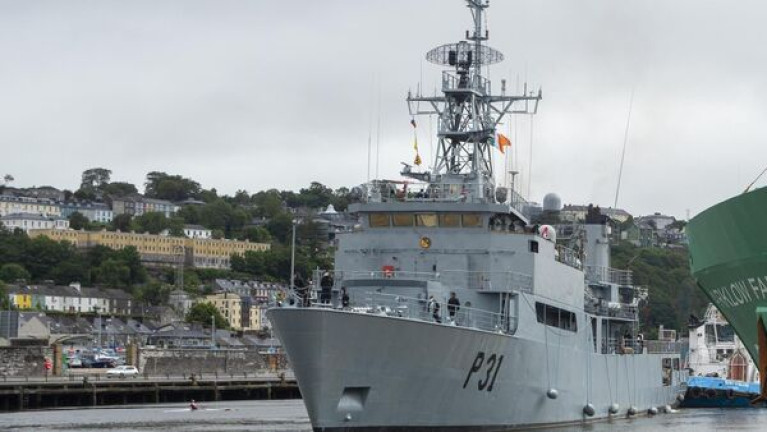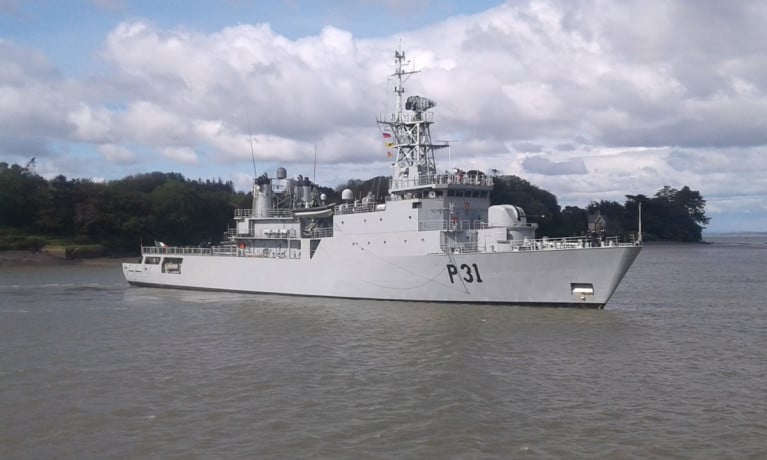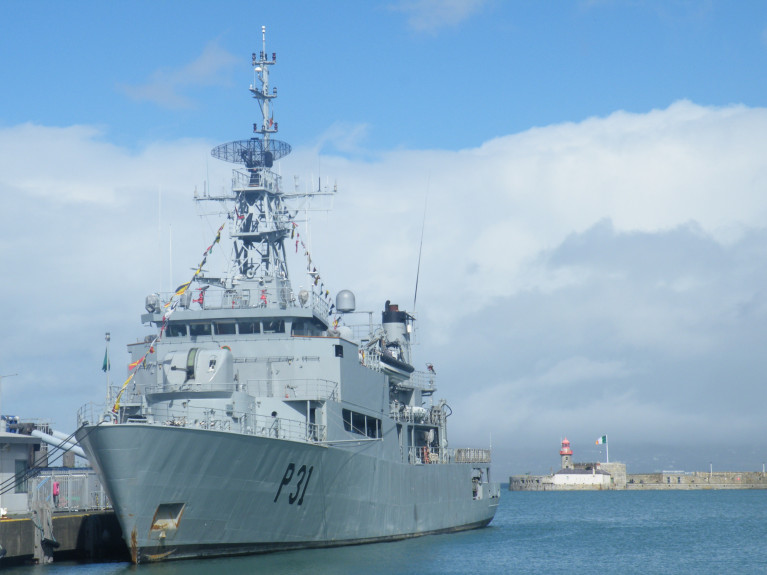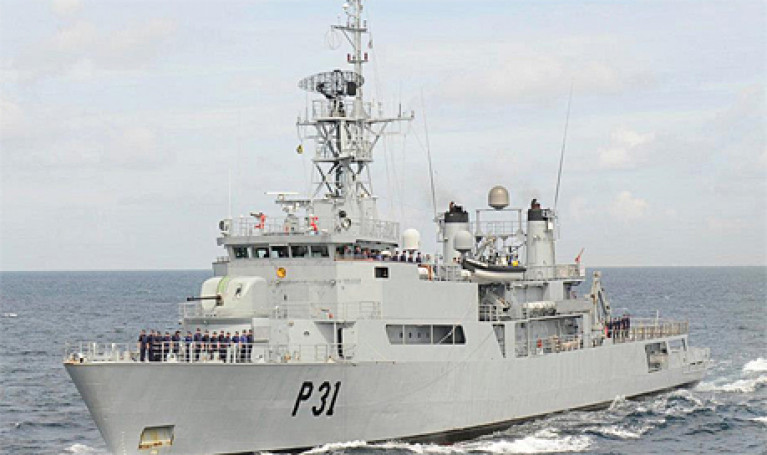Displaying items by tag: LE Eithne
Former Defence Forces chief of staff Vice Admiral Mark Mellett has paid tribute to the LÉ Eithne which left Cork harbour last week to be scrapped abroad.
As Afloat has reported, the 1,920 displacement tonnes ship was the Naval Service’s largest vessel and the last to be constructed in Ireland at the Verolme Cork Dockyard in Cork.
It was decommissioned last year, along with the smaller Peacock class vessels, LÉ Orla and LE Ciara.
On his Linked In page, Mellett recalls how as the ship's gunnery officer he had witnessed her construction in Cork Dockyard.
“LÉ Eithne was fitted with an air surveillance radar and sub surface sonar capabilities. Her optronic fire control system included a laser range, optical and infra red tech tied into a computer system that could calculate the predicted hitting point for the Bofors 57mm weapon system,”he writes.
“Ammunition types included proximity fused high explosive shells with inbuilt radar capacity and doppler shift sensing when the round was closest to the target without having to hit it.”
The ship was also fitted with a flight deck and hangar, capable of carrying the former Dauphin helicopter flown by the Air Corps.
“Most of LÉ Eithne’s service was off the Irish coast in what are statistically the roughest seas in the world. The largest wave ever recorded by scientific instrument was off the north-west Mayo coast in February 2000,”he notes.
He recalls many high profile operations which the ship was involved in, including search for the wreckage of Air India off the south-west coast in 1985.
“In 1986 LÉ Eithne made the first transatlantic crossing by the Irish Navy and in 2005 she was the first Irish naval vessel ever to enter Derry. There the crew marched for a wreath laying service at the Diamond, returning via the Bogside, and all along being applauded by both sides of the community,”he says.
“In 2005 LÉ Eithne was one of the Top 50 Great Places to Work in Ireland. In 2006 she was the first Irish ship to sail to the South Atlantic commemorating Admiral Brown the founder of the Argentine Navy,”he writes.
“ Throughout this time, LÉ Eithne was twinned with Crumlin Children’s Hospital [Dublin] where it was great to see the joy she brought to children over the years,”he says.
“There are so many other stories that are remarkable about Eithne but perhaps the most poignant is her contribution to the migrant rescue operations in the Mediterranean. There, her tireless crews rescued thousands of people and saw many people drown, recovering many bodies.”
“While LÉ Eithne was a remarkable ship, with technology well ahead of her time, when all is said and done she was just steel and technology. What made her a great ship was her people. LÉ Eithne’s service record is a credit to the thousands of women and men who served onboard. A ship does not make a crew - a crew makes a ship!,”he says.
He says it would have been “wonderful” to see the ship retained as a naval museum, similar to HMS Belfast in London and HMS Caroline in Belfast.
“As a nation for historical and institutional reasons we have been largely sea-blind. But this must change. We are not an insignificant island behind an island on the periphery of Europe. We must do all we can to stimulate an interest to protect the extraordinary maritime resource we have,”he says.
“Most of all we must recognise the wonderful people like the crews of LÉ Eithne who have served this State over the years, like so many others who continue to serve. Sovereign rights not upheld are more imaginary than real,”he concludes.
Read Vice Admiral Mellett's post here
The Naval Service said an emotional and fond farewell to its former flagship, the LÉ Eithne, as the distinctive twin funnel vessel departed at the weekend from its homeport of Cork Harbour for the final time.
LÉ Eithne, which was decommissioned in 2022, RTE News reports, is to be towed overseas and be taken apart for scrap after hopes to convert the former Helicopter Patrol Vessel (HPV) into a museum in Irish waters never materialised.
The LÉ Eithne was launched in 1983 at the Verolme Cork Dockyard (V.C.D.) in Rushbrook, neighbouring Cobh, and was completed in 1984, before the yard closed in the same year. The HPV given the pennant number (P31) became the last vessel to be built at V.C.D. for the Naval Service, and as Afloat highlights, as last ever ship to be built in the Republic.
The 1,970 tonnes LÉ Eithne featured technology ahead of its time and had a crew complement of 72 and provision for 8 Air Corps personnel. As the Navy’s first and only HPV, the 84m P30 class ship served for 38 years on missions at home, and was deployed abroad in the Mediterranean, notably on humanitarian rescue missions in more recent years of the ship’s career.
In a statement released on the Naval Service’s Instagram account, it said: "This weekend, we say a heartfelt goodbye to LÉ Eithne, the pride of the Irish Navy and our beloved flagship, as she leaves Cork Harbour for the last time.
"For decades, LÉ Eithne has been a symbol of strength, bravery, and dedication, serving our nation with honour and distinction.
"From countless patrols safeguarding our waters, to providing humanitarian search and rescue in the Mediterranean and forging friendships with navies around the world in the diplomatic role, LÉ Eithne's legacy is etched in the hearts of all who served onboard her."
More here on this end-of-an era naval chapter.
The former flagship of the Naval Service, LÉ Eithne, RTE News reports, has departed the naval base at Haulbowline, Cork Harbour for the final time.
Built as a Helicopter Patrol Vessel (HPV), the 1,920 tonnes ship is to be taken apart for scrap after hopes to convert the 84-metre vessel into a museum never materialised.
The twin-funneled LÉ Eithne was built at the Verolme Cork Dockyard (V.C.D.) in Rushbrooke, (neighbouring Cobh), in 1984 as the last ship launched from the shipyard before it closed that same year.
The HPV was the last and largest vessel built by V.C.D. for the Naval Service and to have helicopter capability, but as Afloat.ie, highlights the LÉ Eithne is also historically significant, given that it was the final ship ever to be built in a shipyard within the Irish Republic.
LÉ Eithne, which had a crew complement of 86 (9 officers and 77 ratings), served for 38 years on missions at home and abroad before it was decommissioned in July 2022. In addition, the twin Coastal Patrol Vessels (CPV) LÉ Ciara and LÉ Orla, also built in 1984, were decommissioned on the same day as the flagship.
Efforts to secure the former HPV involved Cork County Council, which was interested in having the vessel as a potential tourist attraction; however, it was decided that the plan would not be viable.
More here on the LÉ Eithne, which departed the base yesterday and follows a career involving several firsts for the Naval Service flagship, which has formed a major part of Irish maritime heritage. Among the notable firsts, saw the ship visit the southern hemisphere with calls to South America in 2006.
The HPV was named after Eithne, daughter of King Balor, who imprisoned her in a tower on Tory Island, Co. Donegal, as depicted on the ship's crest.
Officials from Defence Recommended L.É. Eithne Be Scrapped to Avoid Repeat of ‘L.É. Aisling Situation’ Involving Warlord
Officials at the Department of Defence, reports The Irish Times, advised that the former flagship of the Naval Service be scrapped amid fears of repeating the “LÉ Aisling situation”, as the ex-Naval Service vessel had eventually ended up in the hands of a Libyan warlord.
The flagship designed as a helicopter patrol vessel (HPV) LÉ Eithne which was decommissioned in 2022, is the last Irish naval vessel to be built in Ireland. In addition Afloat highlights the HPV is also historically significant, given it is the final ship ever to be constructed in the Republic.
In an internal briefing of Defence documents on the fate of the former flagship, drawn up for the Tánaiste and Minister for Defence Micheál Martin, it had shown officials had argued against its sale at auction. This was in light of what had transpired with the final ‘Emer’ class offshore patrol vessel (OPV) LÉ Aisling, warning it was “entirely possible” such a scenario could reoccur.
In March, 2017, the LÉ Aisling was sold by public auction for €110,000 to a Dutch shipbroker as their Avenhorn and towed to Rotterdam. A year later the OPV was resold to a company based in the United Arab Emirates (UAE) for €473,000, which in turn was almost immediately acquired by a company in Libya for €1.3 million.
The former OPV renamed again as Al Karama was however refitted with weapons as Afloat previously reported, having been completely stripped of its weapons prior to being sold by Ireland, was became subject of a report by the United Nations Panel of Experts on Libya. The report found that the 65m vessel had been disposed to a Libyan “warlord”, Khalifa Haftar. This marked a breach of a UN arms embargo by the UAE company.
Once the new role of the former Irish OPV was known and reported, the Department of Defence argued it had no “trailing obligations” in its relationship with the former Naval Service ship, and that the resale of the vessel was a matter for its purchaser.
More from the newspaper here on the LÉ Eithne which had a crew of 86 (9 officers and 77 ratings).
LÉ Eithne: Former Flagship of the Naval Service to Be Sent Overseas for Disposal At Scrap Recycling Facility
LÉ Eithne, the former flagship of the Naval Service which was a helicopter patrol vessel (HPV) along with two coastal patrol vessels (CPV), reports The Irish Times, are to be sent abroad and broken up for recycled scrap, after plans to convert the HPV into a museum came to nothing.
The 1,920 displacement tonnes LÉ Eithne (P31) was the Naval Service’s largest vessel and the last to be constructed in Ireland at the Verolme Cork Dockyard (V.C.D.) was decommissioned last year at the same time as the smaller CPV 'Peacock' class pair LÉ Orla (P41) and LÉ Ciara (P42).
The decommisioning of the patrol vessels was partly due to their age, coincidentally all built in 1984, in addition the vessels were taken out of service due to the ongoing crewing crisis that has impacted the service which has led to not enough sailors to crew all its ships. Two other vessels have since been tied up at the Naval Base on Haulbowline, Cork Harbour, leaving just two ships available for duty at any one time, LÉ Samuel Beckett (P61) and LÉ William Butler Yeats (P63), with one more in reserve of the remaining pair of OPV90/P60 class of offshore patrol vessels (OPV).
As for the fate of the decommissioned trio, there has been much speculation. In the former flagships’ homeport county, Cork County Council had expressed an interest in acquiring the 81m Eithne and converting the HPV into a floating maritime museum at a berth within Cork Harbour. Following this proposal, the Dublin Port Company approached the Department of Defence about the former naval vessel to be used for a similar purpose in the capital.
It is understood that the Philippine Navy had expressed a tentative interest in at least one of the vessels, but these inquiries went nowhere. As Afloat previously reported, this navy during the 1980's had also acquired vessels of the CPV 'Peacock' class from the UK Royal Navy which served in the Hong Kong Squadron.
According to a Department of Defence spokeswoman “a number of organisations” had expressed an interest in acquiring the Eithne as a museum piece or tourist attraction “but following, in some cases lengthy, discussions all these parties withdrew their interest in taking the ship”.
More from the newspaper here.
The former flagship of the Naval Service, the LÉ Eithne (P31) which was decommissioned almost a year ago and which remains in Haulbowline naval base, faces an uncertain future following the withdrawal of two bids.
According to the Department of Defence, both of the bids from the Dublin Port Company and Cork County Council have been withdrawn.
The port and council had each shown their interest in using the former 1,920 tonnes helicopter patrol vessel (HPV) as a possible marine visitor attraction.
Since the bids were withdrawn, Cork City Council and Limerick City and County Council have expressed an interest in taking the twin funnell LÉ Eithne as a visitor attraction that features a helicopter hanger and associated flight-deck.
According to a spokesperson, it has been confirmed that officials have met with both councils about their proposed plans for the LÉ Eithne which is held in great affection given its historical maritime significance, notably as Afloat adds the flagship was the last ever vessel to be built at a shipyard in the Irish Republic.
LÉ Eithne also represented the last patrol ship for the Naval Service to have been built in Ireland and which took place at the Verolme Cork Dockyard (V.C.D.) in Rushbrooke near Cobh in 1984.
The flagship which had a crew complement of 86 (9 officers and 77 ratings) also became the first vessel of the Naval Service to cross the Atlantic Ocean in 1986.
In more recent years L.É. Eithne was the first Naval Service patrol vessel to be deployed to the Mediterranean Sea in 2015 to assist Italian authorities in humanitarian search and rescue (SAR) activities.
More from this RTE News story of last week and the fate of two 'Peacock' class former coastal patrol vessels (CPV), LÉ Orla & LÉ Ciara which were also decommissioned last year. However, they have been replaced by two Inshore Patrol Vessels (IPV) from New Zealand that recently arrived into Cork Harbour to berth in the Naval Basin.
The Peacock twins are no longer berthed in Haulbowline, as Afloat this week observed the vessels rafted together alongside the former V.C.D. shipyard. This site is currently where the Doyle Shipping Group carry out shiprepair and general engineering operations.
Patrol ships of the Naval Service have been decommissioned at the same time, with speculation mounting about what is next for these three vessels.
It is an unprecedented move and questions remain as to whether they will be gifted to foreign governments, sold privately, or even converted into public amenities.
The decommissioning on Friday of (former flagship) LÉ Eithne (built by V.C.D. in Cork Harbour) and the two inshore patrol vessels LÉ Orla and LÉ Ciara will free up some of the skeleton crews who have been maintaining them to work on other ships.
Speculation has mounted in the Philippines that its government is looking for LÉ Orla and LÉ Ciara (former UK Royal Navy Peacock class). It has some of the same type in its navy, mainly used for patrols around its large number of islands.
A Dutch businessman is also understood to be interested in purchasing some of the vessels.
Irish Examiner has more on this end of an era of the trio of 1984 built patrol vessels.
Naval Service Set to Retire Three Ships Next Week - One Might Become a Floating Museum
According to the Journal.ie the Naval Service is set to decommission three patrol vessels next week.
The Government are considering that the former (ageing) Irish Navy flagship the LÉ Eithne become a floating museum either in Cork city or in Dublin.
Sources have said that one consideration for the LÉ Orla and LÉ Ciara is that they be sold to a navy in Asia however the Department of Defence (DOD) has said this has not been confirmed.
“No final decisions have been made regarding the disposal of the three vessels post-decommissioning. Department officials are examining options to determine the most efficient and effective manner to dispose of the vessels,” a spokesperson said.
The DOD said that there were a number of options being considered including “safe and environmentally sound recycling via an EU approved ship-recycling facility”.
They are also considering a sale by auction to a private or foreign Government buyer, a direct transfer between Governments and also to donate the ships for a visitor’s attraction or museum.
“Consultations are ongoing with Dublin Port and Cork County Council regarding the donating of LÉ Eithne for use as a tourist attraction or a museum piece.
More here on the story.
LÉ Eithne: Plea to Convert Flagship into Cork Naval Museum, Rather than Selling Patrol Vessel for Scrap
In a last-ditch effort a campaign is underway to see the Naval Service flagship converted into a maritime museum, rather than sold for scrap.
Cork County Council is writing to the Minister for Defence and the secretary-general of the Department of Defence asking that LÉ Eithne be retained in Cork Harbour as a monument, rather than scrapped or sold.
Some of the main reasons for the request lie with LÉ Eithne’s significant history and association with the region. It was the last Naval Service ship built in Ireland, by the Verlome Cork Dockyard (V.C.D.) in Cobh in 1984, and the first to cross the Atlantic and visit South America.
The flagship and two ageing coastal patrol vessels, ‘Peacocks’ LÉ Orla and LÉ Ciara, are due to be decommissioned this year and rumours have circulated that all three will be sold for scrap metal value, rather than auctioned off.
The reasoning behind that theory is it might avoid further diplomatic embarrassment. The last to be auctioned ended up in the hands of a Libyan warlord, although through no fault of the Irish authorities.
A previous one was given free to Malta. However, it didn’t go down well there as former senior naval commanders on the Mediterranean Island described it as junk.
More from the Irish Examiner on this development to save the unique final Irish built ship whose adopted homeport is Dun Laoghaire Harbour.
A tender has finally been implemented by the Department of Defence for consultants to help it procure a €200m multi-role vessel (MRV) for the Naval Service.
As far back as 2015, the White Paper on Defence identified the need to replace the ageing Naval Service flagship LÉ Eithne with a new vessel, such as an MRV, which would be capable of carrying troops, freight and a helicopter.
The Department of Defence has gone to tender to seek consultants to provide the best design and value for money for the new ship, which it says will be “tailor-made to meet the requirements of the Defence Forces.”
The department said the design specification of the ship must make it “capable of providing a flexible and adaptive capacity for a wide range of maritime tasks, both at home and overseas.”
In addition the Irish Examiner has more and Ireland's membership of the UN Security Council.

































































